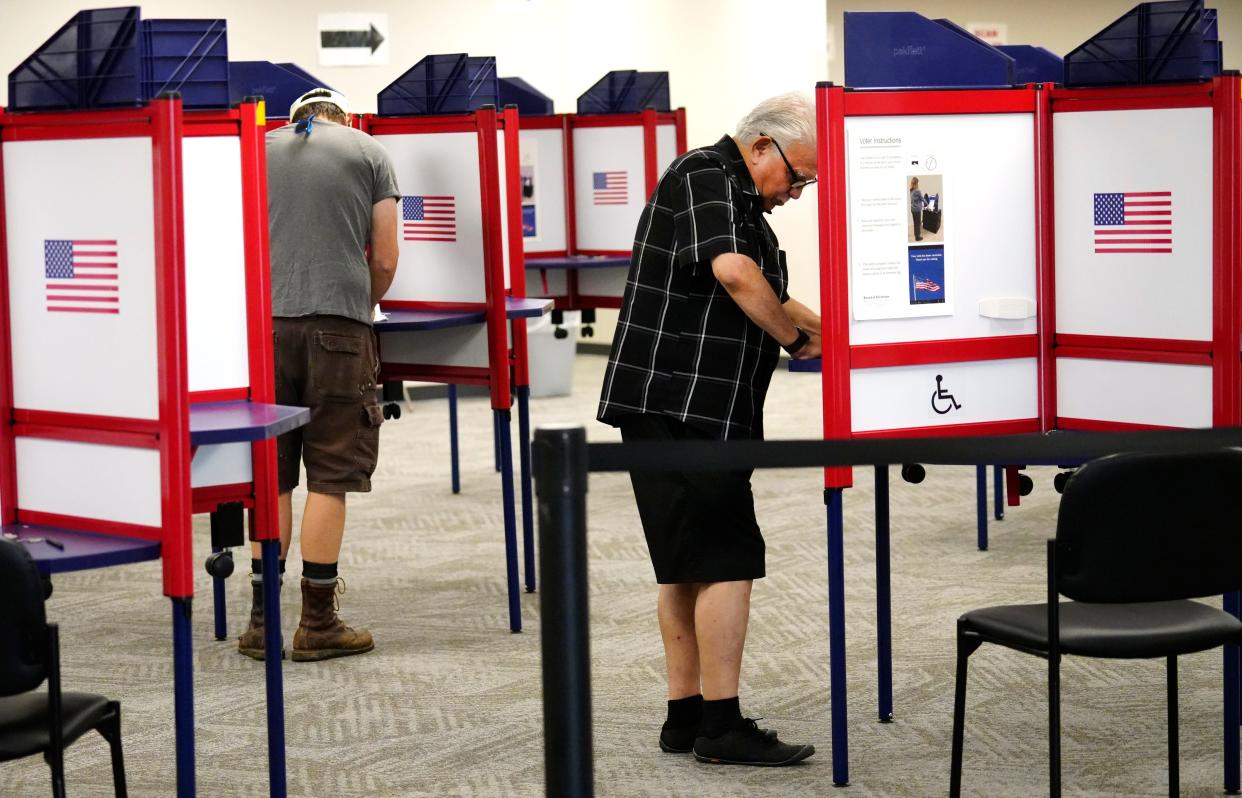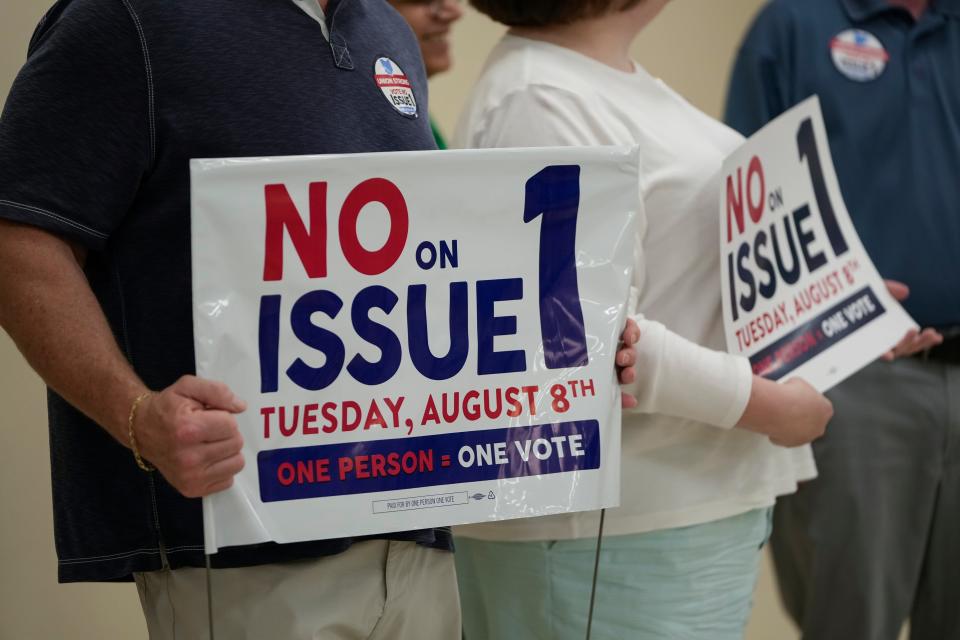Dan Sewell: Issue 1 an effort to pull a fast one on Ohioans | Opinion

Ohio Republicans tried to run a quarterback sneak to defeat the will of the majority, but it’s looking like they might have fumbled when they decided Ohio’s 111-year-old way of passing constitutional amendments suddenly needed to be changed in an unusual August vote.
Make no mistake: Issue 1 is about abortion, an effort to quietly move the goal posts ahead of a November ballot issue in the aftermath of the 2022 U.S. Supreme Court decision overturning the abortion rights case Roe v. Wade after nearly 50 years. Polls consistently show a majority of Ohioans support abortion access, but usually by a margin just below 60% − which Issue 1 would require for passing a constitutional amendment instead of the current simple majority.
Issue 1 is also a test of just how much more electoral chicanery Ohioans will put up with after a year in which they had to vote in two separate primaries because of court-rejected gerrymandered seats across the state. Republicans who currently control the state then decided to do away with August primaries because they said traditionally low turnouts made them too costly to make sense. Until, it turns out, they offer an opportunity to push through a measure that in a November election would have little chance.
If passed on Aug. 8, future citizen-initiated proposed constitutional amendments would not only require 60% approval, the signature-gathering process to get on the ballot would also be doubly tougher − requiring signatures of 5% of voters from the last governor election in all 88 counties instead of the current 44, diluting the role of the state’s most populous counties. It also would eliminate a 10-day period allowing replacement of any citizens found faulty on the Ohio secretary of state's office.
In effect, a vote for Issue 1 is a vote to weaken the power of your own vote.
However, the element of surprise was lost quickly. Bipartisan groups of both former Ohio governors and attorneys general spoke out against Issue 1 months ago. Two-term Republican Gov. Bob Taft called Issue 1 an effort to "game the system." Republican Maureen O’Connor, who served as Ohio’s Chief Supreme Court Justice for 12 years, was even stronger in a CBS interview last month, saying of Issue 1: "It’s misleading. It’s deceptive. And If it weren’t so serious, it would be laughable."
She said at best, Issue 1 − which backers claim is needed to "Protect Our Constitution" − is trying to fix a system that isn’t broken. Backers warn that the state is vulnerable to "out-of-state special interests" pushing through all manner of threatening constitutional changes. Of course, the pro-Issue 1 effort is getting funding from a right-wing Illinois billionaire.

Mark Wert, a recently retired editor at The Enquirer, did some research on how Ohio’s current amendment system has fared over its 111 years. He found that more than two-thirds of the constitutional amendments proposed came from the Legislature, with 55% overall passing. The pass rate for those coming from initiatives such as the planned November abortion issue has been 27%, Wert found. Eight constitutional amendments, including casino gambling and increasing the minimum wage, have passed with less than 60% approval. Wert’s research also showed that this will be only the second time a constitutional amendment has been put before voters in August, and that the majority of such votes have been in November, when voter turnout is traditionally highest.
The nation’s high court has ruled that the states should determine their own laws on abortion − it didn’t say to try to do so with the fewest number of voters possible which Ohio Republicans seemed to have hoped for. However, early voter turnout has been running well ahead of in other recent elections, indicating the apparent GOP hope for a small number of voters will be thwarted. Some Issue 1 supporters are getting increasingly shrill as Aug. 8 near, talking less about "protecting our Constitution" and more about stopping abortion, drag queens, protecting the Second Amendment and even saving "parental control" over children.
One argument they keep using is that the Ohio Democratic Party and other organizations opposing Issue 1 are hypocritical because their own internal constitutions require a 60% (or in some cases, higher) vote for changes. It’s unclear why government should be bound by the rules of organizations. Should voters be required to pay membership fees; go through initiations; be allowed to secretly blackball candidates?
Abortion is an emotional and complex issue, but those who oppose abortion should consider that even requiring a 60% threshold doesn’t mean the November issue won’t pass anyway since polls without an issue on the ballot yet have put support for abortion access at as high as 59%. So you would have weakened your voting power for other issues in the future without achieving anything.
Issue 1 is a bad play call for Ohio.
EXTRA POINTS
All aboard for railroad sale vote

Also on Nov. 7, Cincinnatians will weigh in on the proposed sale of the railway that runs from the city to Chattanooga, Tennessee. The nation’s only city-owned railway is governed by an independent board that recommends selling it to Norfolk Southern for $1.6 billion. Norfolk Southern has been leasing the railway for some $25 million a year.
The city’s plan is to put the sale proceeds into a trust, then use investment earnings to fund city infrastructure needs. Mayor Aftab Pureval has estimated the trust would produce annually for the city more than twice what the rental does. Opponents say the city should hold on to a reliable revenue resource, but unless you don’t trust the mayor and the bipartisan railway board members, it seems like an easy "yes."
And a simple majority wins.
No Bragg, just fact: He was a loser
Presidential candidates Gov. Ron DeSantis and former vice president Mike Pence have both pledged as they campaign for the Republican nomination to give Fort Liberty, North Carolina, its old name back.
The army base had been named Fort Bragg until this June but got the new name after the work of a federal commission to remove the names of Confederate military leaders from Department of Defense installations. Having a fort named for Gen. Braxton Bragg, a slaveholder who fought against his nation, doesn’t make sense for the diverse U.S. military, nor does honoring an officer Civil War historians generally rate as ineffective or even incompetent.
Besides launching an ill-conceived invasion of Kentucky, Bragg’s army lost most of its major battles. After being routed by the forces of Ohioans Gens. Ulysses S. Grant and William T. Sherman in the Chattanooga campaign of 1863, Bragg was relieved of his command by Confederate President Jefferson Davis.
Taking his name off a U.S. base wasn't an effort to erase history − there are plenty of well-preserved National Park Service battlefields where he fought available to visitors to tour − but corrects a long-standing mistake.
Dan Sewell is a regular Opinion contributor. Contact him at dsewellrojos@gmail.com.
This article originally appeared on Cincinnati Enquirer: Dan Sewell: Issue 1 an effort to pull a fast one on Ohioans | Opinion

